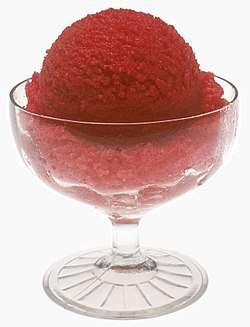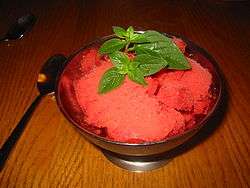Sorbet
Sorbet (/sɔːrˈbeɪ/) or sherbet is a frozen dessert made from sugar-sweetened water with flavoring – typically fruit juice, fruit purée, wine, liqueur or honey. The terminology is not settled, but generally sorbets do not contain dairy ingredients, while sherbets do.
 Raspberry sorbet | |
| Course | Dessert |
|---|---|
| Serving temperature | Frozen |
| Main ingredients | Water, sugar, flavoring (fruit juice or purée, wine, or liqueur, and very rarely honey) |

Background
It is believed that sorbets originated in ancient Persia.[1][2] There are a number of legendary origin myths, unsupported by any known evidence, that attribute the origins of sorbet to historical figures like the Roman Emperor Nero, Marco Polo and the Italian duchess Catherine de' Medici.[3][4][5]
Romans did not add ice to their drinks because easily accessible ice along the lower slopes was not sanitary for use in food preparation.[6] Iced drinks were believed to cause convulsions, colic and a host of other ailments.[3]Hippocrates was known to have criticized chilled drinks for causing "fluxes of the stomach", while Seneca lambasted the extravagant costs associated with iced desserts in an era without refrigeration.[4] Despite this, ice and snow were prized ingredients in ancient cuisines including Japanese, Chinese, Greek and Roman cuisines.[3]
The first Western mention of sherbet is an Italian reference to something that Turks drink. The word sherbet entered the Italian language as sorbetto, which later became sorbet in French.[7] August Escoffier describes sorbet as "very light and barely-congealed ices, served after the Entrées. They serve in freshening the stomach; preparing it to properly receive the roast. They are appetizers and help to aid digestion."[8] He recommends that they register 15° on the saccharometer and be of drinkable consistency.[8]
In the 17th-century, England began importing "sherbet powders" from the Ottoman Empire made from dried fruit and flowers mixed with sugar.[6] By 1662, a coffeehouse in London advertised the availability of "sherbets made in Turkie of Lemons, Roses and Violets perfumed".[9] In 1670, Café Procope opened in Paris and began selling sorbet.[10] (In the modern era sherbet powder is still popular in the UK.) When Europeans figured out how to freeze sherbet they began making sorbetto by adding fruit juices and flavorings to a frozen simple syrup base. In the US sherbet generally meant an ice milk, but recipes from early soda fountain manuals include ingredients like gelatin, beaten egg whites, cream, or milk.[6]
Agraz is a type of sorbet that is usually associated with the Maghreb and north Africa. It is made from almonds, verjuice, and sugar. It has a strongly acidic flavour, because of the verjuice. (Larousse Gastronomique)
Givré (French for "frosted") is the term for a sorbet served in a frozen coconut shell or fruit peel, such as a lemon peel.
Preparation
Like granitas and other ices, sorbet can be made without an ice cream maker. Alcohol, honey or corn syrup can be added to lower the freezing point and make softer sorbets.[10]
Variations
Mulled wine sorbet can be made with red wine, orange, lemons, mulling spices, ruby port, and egg whites. Muscat sorbet is made with dessert wine, lemon juice, and egg whites.[11] Tart sorbets are also served as palate cleansers between savory courses of a meal.[5]
Terminology
Canada
In Canada, sherbet is defined as a "frozen food, other than ice cream or ice milk, made from a milk product". A typical Canadian sherbet may contain water, a sweetening agent, fruit or fruit juice, citric or tartaric acids, flavouring preparation, food coloring, sequestering agent(s), and lactose.[12]
American
.jpg)
Commercially produced sherbet in the United States is defined in the Code of Federal Regulations as a frozen product containing one or more optional dairy products.[13] Sorbet, on the other hand, is made with sweetened ice and no dairy; it is similar to Italian ice, but made with real fruit instead of imitation flavoring.[14][15]
Homemade sherbets do not always contain dairy. Early 20th-century American recipes for sherbet include some versions made with water. The American Kitchen Magazine from 1902 distinguishes "water ices" from sherbets, explaining that "sherbets are water ices frozen more rapidly, and egg white or gelatin is often added to give a creamy consistency". In one recipe for pineapple sherbet, water may be used in place of milk. It also separately discusses "milk sherbets".[16]
According to The American Produce Review (1913) "Sherbet is a frozen product made from water or milk, egg whites, sugar, lemon juice and flavoring material". Sherbets are made from a base of "plain ice" which is water, sugar, egg whites, and lemon juice.[17]
See also
| Wikimedia Commons has media related to Sorbets. |
| Look up sorbet in Wiktionary, the free dictionary. |
References
Notations
- Lang, Jenifer Harvey, ed. (1988). "Agraz". Larousse Gastronomique: The New American Edition of the World's Greatest Culinary Encyclopedia. New York: Crown Publishers. ISBN 0517570327. OCLC 777810992.
Footnotes
- Marks, Gil (2010-11-17). Encyclopedia of Jewish Food. HMH. ISBN 978-0-544-18631-6.
- Cousineau, Phil (2012-09-11). The Painted Word: A Treasure Chest of Remarkable Words and Their Origins. Simon and Schuster. ISBN 9781936740253.
The ancient Persians created a delicious and cooling concoction called sharbat
- Goldstein, Darra, ed. (2015). The Oxford Companion to Sugar and Sweets.
- Toussaint-Samat, Maguelonne (2009). A History of Food. Wiley. p. 675.
- Weir, Caroline; Weir, Robin (2010). Ice Creams, Sorbets & Gelati:The Definitive Guide. Grub Street Cookery. p. 9. ISBN 1909808938.
- Weir, Robin; Quinzio, Jeri (2015-07-23). "Sherbet". The Oxford Companion to Sugar and Sweets. Oxford University Press. ISBN 978-0-19-931339-6. Retrieved 2018-07-20 – via Oxford Reference.
- Cousineau, Phil (2012-09-11). The Painted Word: A Treasure Chest of Remarkable Words and Their Origins. Simon and Schuster. ISBN 9781936740253.
By the time it left the deserts of Persia for the cities of Europe it had been transformed into an "Orientalized" dessert called sorbetto in Italian and sorbet in French.
- August Escoffier, The Escoffier Cook Book, 1976, ISBN 0517506629, translation of Le Guide Culinaire, 1903, p. 853
- Jurafsky, Dan (2014-09-15). The Language of Food: A Linguist Reads the Menu. W. W. Norton & Company. ISBN 978-0-393-24587-5.
- Pappas, Lou Seibert (April 1997). Sorbets and Ice Creams: And Other Frozen Confections. Chronicle Books. p. 11-15. ISBN 978-0-8118-1573-4.
- Liddell, Caroline; Weir, Robin (1996-07-15). Frozen Desserts: The Definitive Guide to Making Ice Creams, Ices, Sorbets, Gelati, and Other Frozen Delights. Macmillan. ISBN 978-0-312-14343-5.
- "Sherbet". Canada Food and Drug Regulations. Government of Canada. Retrieved 11 August 2019.
- "Requirements for Specific Standardized Frozen Desserts". Accessdata.fda.gov. 2013-04-01. Retrieved 2014-08-09.
- Gallery, Christine (12 June 2017). "What's the Difference Between Sherbet and Sorbet?". The Kitchn. Archived from the original on 2017-02-12. Retrieved 4 July 2017.
- Marshall, Robert T.; Goff, H. Douglas; Hartel, Richard W. (2003). Ice Cream. Springer Science & Business Media. ISBN 978-0-306-47700-3.
- The American Kitchen Magazine. Home Science Publishing Company. 1902.
- The American Produce Review. 1913.